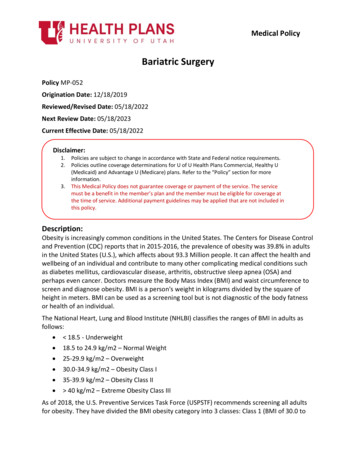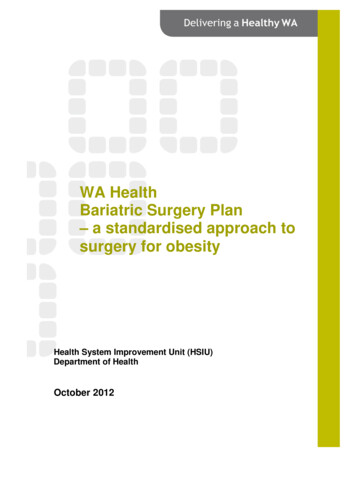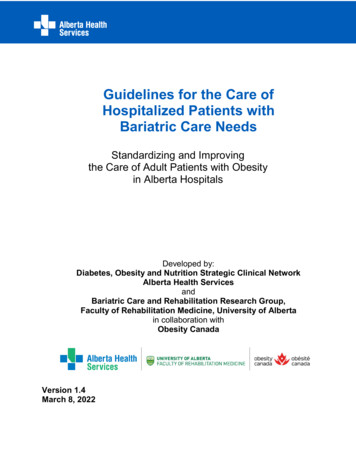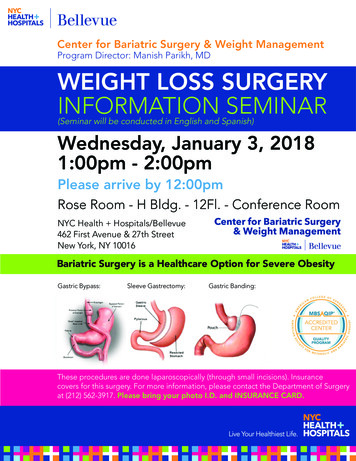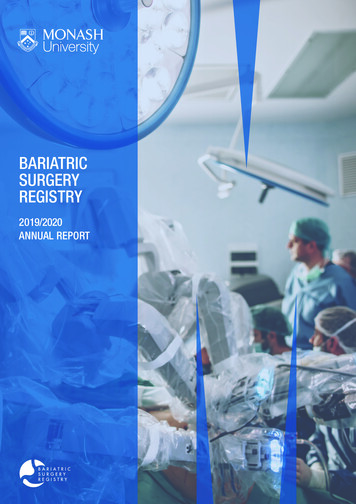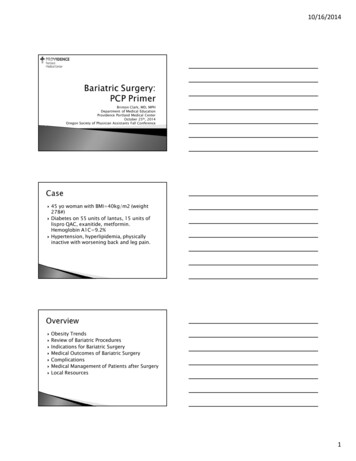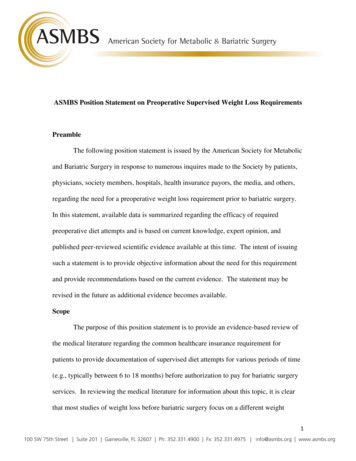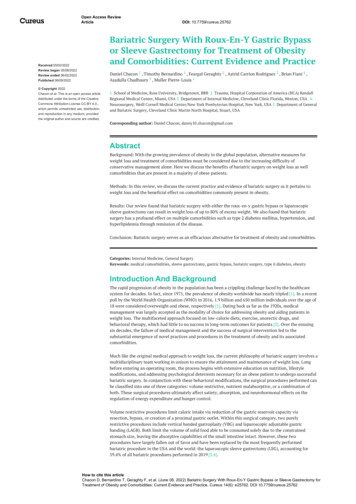
Transcription
Bariatric Surgery for Severe Obesity:Determinants of Use and Economic ImpactRafael Alfonso-CristanchoA dissertationsubmitted in partial fulfillment of therequirements for the degree ofDoctor of PhilosophyUniversity of Washington2013Reading Committee:Sean D. Sullivan, ChairDavid R. FlumDavid E. ArterburnLouis P. Garrison, Jr.Program Authorized to Offer Degree:Pharmaceutical Outcomes Research and Policy ProgramSchool of Pharmacy1
Copyright 2013Rafael Alfonso Cristancho2
University of WashingtonAbstractBariatric Surgery for Severe Obesity:Determinants of Use and Economic ImpactRafael Alfonso CristanchoChair of the Supervisory Committee:Sean D. Sullivan, PhDObjectives: Obesity in the U.S. population is a major public health problem with importantclinical and economic implications. Bariatric surgery is currently the most effective longterm weight loss treatment for morbid obesity but less than 2% of the potentially eligiblepopulation has undergone the procedure. Our aims were to: 1) determine the patientcharacteristics associated with receiving a bariatric procedure among eligible patients; 2)identify patient characteristics that could be used as predictors of resource use and costs inseverely obese patients with and without bariatric surgery; and 3) estimate and project thedifferences in long-term costs and outcomes across different clinically defined populationsundergoing bariatric surgery compared to non-surgical approaches, refining a previouslydeveloped cost-effectiveness model.Methods: We used electronic medical records from members of Group Health Cooperative,based in Washington State to identify severely obese individuals, eligible for bariatricsurgery, from 2004 to 2010. The probability of undergoing bariatric surgery was assessedusing multivariate logistic regression adjusting for demographic and clinical characteristics,as well as patterns of practice. To determine the predictors of costs, we used generalized3
linear models for both groups with similar adjustment variables. We created a propensityscore matched cohort based on specific characteristics previously identified at the date ofsurgery and the assigned index date for those who did not have surgery. Finally, we usedthese data to update a previously developed cost-effectiveness model to re-estimate thecost-effectiveness of bariatric surgery compared to non-surgical interventions.Results: A total of 48,166 subjects were identified as eligible for bariatric surgery. Only1,129 had bariatric surgery. The characteristics associated with having a bariatric procedurewere: having insurance coverage for the procedure (OR 5.61; 4.71-6.68), higher body massindex (BMI) (1.10; 1.09-1.11), and older age (1.00; 1.00-1.01). The presence ofcomorbidities was associated with higher odds of having surgery. Examining comorbiditiesindividually, only coronary heart disease was not associated with the surgery (0.96; 0.741.26). These characteristics changed over time, showing time trends towards increasingnumbers of older adults and subjects with lower BMI having the procedure in the recentyears. For costs, total annual costs were higher prior to surgery in the bariatric surgerygroup but decreased more (in absolute and relative terms) after the surgery compared to thenon-surgical group. The total health care costs post-surgery for both groups were primarilydriven by inpatient costs. The presence of comorbid conditions was associated with greaterannual total costs in both groups. Major cardiovascular risk factors, such as coronary heartdisease, hypertension, diabetes, and a higher comorbidity index, were associated with thehighest increase in mean annual total costs. Despite being more expensive, bariatric surgeryis cost-effective due to the impact on weight loss, which is associated with improved lifeexpectancy and quality of life after the procedure. The incremental cost-effectiveness ratioof the bariatric surgery is sensitive to the presence of multiple comorbidities, mainly due tothe reduction in the differences in the lifetime costs between surgical and non-surgicalinterventions for patients with multiple comorbidities.Conclusions: There are demographic, clinical, and insurance differences among subjectseligible for bariatric surgery that receive and do not receive the surgery. The presence ofspecific comorbid conditions increases the probability of surgery and is associated withhigher total costs in this population. The cost-effectiveness of these procedures alsodepends on the presence of specific comorbid conditions. Understanding these differencescould better inform the decisions that patients, clinicians, payers and policy-makers face inaddressing the problem of increasing population obesity.4
Table of ContentsChapter 1: Who is getting bariatric surgery?. 8Background. 8Methods: . 11Results . 14Discussion. 16References . 19Chapter 2: Costs Associated with Bariatric Surgery . 29Background. 29Methods: . 31Results: . 35Discussion. 38References . 42Chapter 3: Cost-Effectiveness of Bariatric Surgery: A Revised Estimate . 53Background. 53Methods . 55Results . 59Discussion. 61Acknowledgements . 64References . 65Appendix 1. . Error! Bookmark not defined.Appendix 2 . Error! Bookmark not defined.Appendix 3 . Error! Bookmark not defined.Appendix 4. . Error! Bookmark not defined.5
List of figures by chapterChapter 1:Figure 1. Identification and distribution of subjectsFigure 2. BMI distribution in subjects receiving bariatric surgeryFigure 3.Age distribution in subjects receiving bariatric surgeryChapter 2:Figure 1. Adjusted Mean Annual Total Costs by surgery.6
List of tables by chapterChapter 1:Table 1. Unadjusted comparison of characteristics of the patients eligible for bariatric surgery, bythose who did and did not undergo surgery, 2004 to 2010 in Group Health CooperativeTable 2. Multivariate logistic regression: multivariable adjusted odds ratio for having bariatricsurgery.Table 3. Multivariable adjusted odds ratios (OR) for having bariatric surgery adjusted by year ofsurgery.Chapter 2:Table 1. Description of unadjusted total annual costs from index year by cohortTable 2. Propensity Score Matched comparison of characteristics of the patients eligible forbariatric surgery, by those who did and did not undergo surgery, 2004 to 2010 in Group HealthCooperative.Table 3. Propensity Score Matched Annual Total Costs by Group and Year from IndexTable 4. Adjusted Model for the Propensity Matched Group using Generalized Linear ModelsTable 5. Estimated Adjusted Total Annual Costs by Surgery GroupChapter 3:Table 1. Review of Base-case incremental costs per QALY gained in studies using QALYs asoutcome measureTable 2. Results of the 5-year simulation for the base case (53 year old Female with BMI 44 kg/m2,using GHC dataTable 3. Results of the lifetime simulation for the base case (53 year old Female with BMI 44kg/m2, using GHC dataAppendix 1:Table 1. ICD-9 codes for identification of subjects and operational definitionsAppendix 2:Table 1. All sample of adults initially identified in the databaseTable 2. Eligible subjects included in the cohortAppendix 3:Table 1. Description of unadjusted total costs in Non surgery subjects (All Sample-Unadjusted)Table 2. Description of unadjusted total costs in surgery subjects (All Sample-Unadjusted)Table 3. Propensity-matched total annual cost by cohortTable 4. Survival and mean total annual costs by cohortTable 5. Assessment of costs distribution for a two-part modelAppendix 4:Table 1. Clinical and cost inputs for the initial 5-year period post-surgery (53 year old female with aBMI of 44 kg/m2 and no post-surgical complications).Table 2. Results of the lifetime simulation for the base case (53 year old Female with BMI 44kg/m2, using Medicare data)7
Chapter 1: Who is getting bariatric surgery?BackgroundObesity is a significant problem worldwide (1). Recent data suggests that, in theU.S., almost two-thirds of the population is overweight (2), defined as a body mass index(BMI) 25 kg/m2and over, and half of these are obese, BMI 30 kg/m2 or greater (2, 3).Severe obesity, defined as BMI 40 kg/m2, has been reported to be present in 5.7% of theadult population in the U.S., accounting for more than 15 million people (3), and continuesto be the fastest growing obesity group by BMI category (3-5). Obesity is associated withmultiple chronic conditions such as diabetes mellitus, hypertension, dyslipidemia, coronaryheart disease, sleep apnea, asthma, gastroesophageal reflux, fatty liver disease, andosteomuscular injuries leading to back pain and arthritis (6-9). Additionally, several typesof cancers, such as esophageal, gallbladder, colorectal, and kidney, are often reported inassociation with obesity (9), as well as a higher risk of endometrial and breast cancer inpostmenopausal women who are overweight or obese (8, 10-11). The impact of obesity interms of reducing life expectancy, decreasing the quality of life and increasing healthcareexpenditures has been widely reported and continues to grow in the US and the rest of theworld (10-13).Treatment for obesity ranges from life style modifications, such as diet and exercise,to pharmacotherapy, and to surgical interventions with varying degrees of invasiveness.The effectiveness, safety, and costs of these interventions also vary. Life stylemodifications in different levels of intensity and in multiple combinations havedemonstrated low to moderate effectiveness for long term weight loss (14,15). There arefew effective pharmaceutical products labeled for morbid obesity. Their studies reporthigher short term weight loss compared to life style modifications or placebo, but there isno solid evidence for their long term effectiveness, and when therapy is stopped, patientsusually regain most of their lost weight back in the following years.(16). Surgical8
interventions to treat severe obesity, known as bariatric procedures, have shown better longterm efficacy in reducing weight and improving comorbid conditions compared to nonsurgical interventions (17-22). These positive effects and the development of minimallyinvasive surgical techniques have resulted, according to the US Agency for HealthcareResearch and Quality (AHRQ), in an increase in bariatric surgery by nine-fold for theperiod 1998-2004 (23). In the U.S., as in most parts of the world, the Roux-in-Y GastricBypass (RYGB) is the most common bariatric procedure (24-26), accounting for almost80% of the total number of procedures (26). In a 2009 study with 4,776 patients undergoingfirst time or primary bariatric procedures, the most common procedure was RYGB in 3,412(71.4%) cases (27), and according to the American Society for Metabolic and BariatricSurgery, in a six-year period (2003-2009), the number of RYGB procedures more thandoubled to a significant 220,000 surgeries per year (28). RYGB can be performed throughan open abdominal approach (ORYGB) or with a less invasive laparoscopic technique(LRYGB) (29). Because of the improved recovery time, decreased pain and relative safetyof LRYGB, it is rapidly replacing the ORYGB as the procedure of choice (30). The mosttroubling side effects of these procedures are anastomotic leak, strictures or marginal ulcers(33-33). In relatively rare instances, medical or surgical complications can lead to death(approximately 0.5%) in the 30 days after the surgery (36); however, severe complicationsoccur in less than 2% of the patients undergoing these procedures (18, 22, 26). Althoughthe safety of these procedures continues to improve, the costs remain high (37).According to previous reports, the disparity in health care access and delivery ofbariatric surgery is mainly associated with insurance status and socioeconomiccharacteristics, but many other factors could be affecting this association (38, 39). Our aimfor the current study was to examine the differences in the clinical characteristics amongeligible patients who received and do not received the bariatric procedure in a single large,integrated health insurance and care delivery system in the Pacific Northwest. Wehypothesized that patients with specific characteristics were may be more likely to receive asurgical intervention for obesity than others. To our knowledge, this assessment has notpreviously been performed in the US, and could better inform whether the characteristics ofpatients receiving the surgery are representative of the overall eligible population. These9
results could be used to address barriers to bariatric surgery access and help to guideproviders and policy makers to establish policies to improve access and delivery of theseeffective interventions to the patients who are likely to benefit from them.10
Methods:DesignA longitudinal cohort of adults with severe obesity who were potentially eligible forbariatric surgery were identified and followed between 2004 and 2010.Data SourcesWe used data from members of Group Health Cooperative (GHC) in WashingtonState. GHC is a healthcare system that integrates care and coverage serving approximately620,000 Washington State residents. Compared to the area population, the population fromGHC includes fewer persons with high and low incomes, but is generally representativewith regard to age, gender, and ethnicity. The Electronic Medical Record (EMR) andadministrative, clinical, and laboratory data were used to identify the subjects potentiallyeligible for the study. Additionally, GHC data systems allow serial tracking patient bodyheight and weight within the EMR, which is a very important variable for obesityevaluations and is often missing in other large administrative datasets.PopulationBased on the recommendations for eligibility for bariatric surgery of the NationalInstitute of Health (NIH) guidelines for the identification, evaluation, and treatment ofoverweight and obesity (40), we identified adult subjects with BMI of 35 kg/m2 or higher.For those subjects with BMI between 35 and 40 kg/m2, we additionally identified theInternational Classification of Diseases, version 9 (ICD-9-CM) codes for relevantcomorbidities that established eligibility for surgery: diabetes, hypertension, dyslipidemia,sleep apnea, gastroesophageal reflux disease, osteoarthritis, metabolic syndrome, ordepression. Subjects with BMI equal or higher than 40 kg/m2 were included regardless ofthe presence or not of comorbidities. For all subjects, we excluded those who were pregnantor lactating or had other relative contraindications to bariatric surgery, such as dementia,psychosis, disabling neurologic disorders, HIV, cancer, inflammatory bowel disease,11
cirrhosis, dialysis, or current substance abuse and other related conditions. These diagnoseswere defined based on their respective ICD-9 codes (Figure 1; Appendix 1).Subjects’ demographic and clinical characteristics were assessed, as well as theinformation about insurance status and coverage. Participants in GHC can belong toMedicare, Medicaid, the Basic Health Plan (a state-supported plan for low-incomeresidents), the state government employees plan, federal workers, and/or individuallypurchased plans. These different health plans may offer different types of coverage forbariatric procedures: some will cover the procedures and others do not. We identifiedcoverage for bariatric surgery and the enrollment periods when this specific coverage wasavailable for each patient as a separate variable in our analysis to explore its effect of thelikelihood of receiving bariatric surgery. Specific comorbidities considered as independentmajor cardiovascular risk factors, such as diabetes mellitus, hypertension, dyslipidemia, andcoronary heart disease, were identified using ICD-9-CM codes. Other comorbidities andhealth status reports were assessed using a comorbidity index. Specifically, we used Quan’senhanced version of the Charlson comorbidity index which has been reported to match oroutperform the original Deyo and Elixhauser ICD-9-CM coding algorithms in predictingin-hospital mortality (41). For the bariatric surgical interventions, we identified the patientsundergoing these procedures using ICD-9-CM and CPT codes (full list available atrequest). The specific type of bariatric surgery and the dates of the procedure wereidentified as used as the index date for the surgical patients.Statistical AnalysisWhen assessing access and use of health services, including surgical interventionslike bariatric surgery in this case, it is recommended to take into account both societal andindividual determinants that could help to explain key patterns and trends in the use ofhealth resources. Following these principles, we adapted the conceptual framework of thebehavioral model for health care utilization from Andersen-Newman (42,43). Based on thisadapted model, we hypothesized that the access and use of healthcare resources associatedwith bariatric surgery would depend on: (1) the predisposition of the individual to useservices (predisposing factors: age and gender); (2) the member's ability to secure services12
(enabling characteristics: insurance status and coverage for the procedure); and (3) themember’s illness level (need for health care: comorbidities, health status, and BMI). Weidentified variables relevant to each of these categories for our analysis.The data were de-identified in accordance with the Health Insurance Portability andAccountability Act’s definition of a limited dataset. The Office of Research Subjects fromthe University of Washington and GHC deemed the study to be exempt from federalregulations because the research activities were considered to be of minimal risk to patients.Since the outcome of interest was the ability to obtain or not obtain a bariatricprocedure, we developed a multivariate logistic regression model to determine thecharacteristics that differed between the eligible subjects who had bariatric surgery andthose who did not undergo the procedure between 2004 and 2010. For all subjects, weconsidered the available information prior to their date of surgery, particularly regardingthe comorbidities. As the trends in the adoption of bariatric surgery and obesity may alsoplay a role in the observed changes, we also performed additional analysis at annualintervals to assess potential differences or trends in the use of the surgery during the periodof analysis. All analyses were conducted using STATA Version 12.1, StataCorp. 2011.College Station, TX: StataCorp LP.13
ResultsWe identified a total of 48,166 adult subjects with a reported BMI higher than 35kg/m2 from GHC electronic databases between 2004 and 2010; and among those, 29,679were identified as eligible for bariatric surgery based on the eligibility criteria outlinedabove and consistent with the recommendations from the National Institute of Health (40).The most common reasons for excluding patients from the cohort were the lack ofadditional comorbidities in the group of subjects with BMI between 35 and 40 kg/m2 andthe presence of comorbidities described above as exclusion criteria to be eligible forbariatric procedures. Among the eligible population, 17,071 (57%) had a health plan withbariatric surgery coverage during the follow up; and there was a slightly higher proportionof females, the mean age was 49 (SD: 12.3) years old, and the mean BMI was 40 (SD: 7.2)kg/m2. Overall, hypertension was the most common major cardiovascular risk factorreported in this subpopulation, found in 45% of the subjects, followed by dyslipidemia anddiabetes mellitus, both present in almost a quarter of the patients in this cohort. A smallerproportion of patients were identified with coronary heart disease. The mean comorbidityindex was 0.34 (SD: 0.65) and only 4.8% of the patients had an index of 2 or greater. Atotal of 1,129 (3.8%) subjects were identified as having a bariatric procedure during thistime period.In the initial unadjusted analysis, comparing patient characteristics across those whodid and did not have bariatric surgery, we found significant differences between the twogroups. Patients who underwent bariatric surgery were more likely to be female, have ahigher BMI, and have insurance coverage for the procedure. We also found significantdifferences in comorbidities between the two groups, with the patients who underwentbariatric surgery having a higher likelihood of having diabetes, hypertension, ordyslipidemia, as well as a higher score on Quan's comorbidity index. Age was marginallyassociated with the likelihood of receiving bariatric surgery, and we did not find significantdifferences by the presence coronary heart disease (Table 1).14
The multivariate adjusted logistic regression analysis showed that having coverage forbariatric surgery had the strongest association with undergoing the procedure, increasingthe odds of surgery by more than 5 times. Being female and having a higher BMI were alsoassociated with the procedure. Greater comorbidities on the Quan’s index were found toalso increase the probability of having the procedure; however, coronary heart disease wasnot significantly different between the two groups (see Table 2). When the analysis wasrestricted to the subpopulation of the 17,071 subjects with bariatric surgery coverage, theresults were similar.Considering the distribution of the surgical procedures over time, in addition to thepotential changes in the prevalence of obesity and increasing number of bariatric surgeriesin this time period, we performed additional analysis to adjust for time trends between 2004and 2010. The surgical cohort revealed significant changes over time, both in thecharacteristics of the population eligible for surgery and the characteristics of the subjectsundergoing surgery. The odds associated with having bariatric surgery increased over timeduring the study period as a reflection of the distribution of the proportion of patientsundergoing bariatric surgery every year. Almost half of the patients who had bariatricsurgery had the procedure in the last 3 years of the study period. The population eligible forsurgery showed an increase in the proportion of young adults (from 16 to 22%), females(from 58 to 62%), and higher mean BMI (from 38.3 to 41 Kg/m2). For the subjectsundergoing surgery, we identified a different trend with an increased number of olderpatients with lower BMIs receiving surgical interventions (See Figure 2a and 2b).15
DiscussionIn this long-term analysis of a population-based cohort of severely obese patientswho were eligible for bariatric surgery, having insurance coverage for the procedure wasthe single characteristic most strongly associated with having bariatric surgery. Beingfemale, having higher BMI, diabetes, or hypertension, or dyslipidemia, or having a greateroverall burden of comorbidities were each also associated with a higher odds of undergoingsurgery independent of bariatric insurance coverage. These results seem to be consistentwith the recommendations for bariatric surgery which promotes the use of bariatric surgeryfor patients with specific comorbidities unless a patient has a specific contraindication forthe procedure (40).Previous studies, using the same NIH eligibility criteria, and based on theinformation of the population who participated in the National Health and NutritionExamination Survey (NHANES) (2, 3), have reported the proportion of eligible patientsfor bariatric procedures in the United States; using the number of bariatric surgeriesperformed in the U.S. during the same period, the authors estimated the proportion ofeligible patients who had undergone the procedure to be approximately 0.5% of the totalpotential eligible population (39). This proportion is much lower than what we found in ourresults, where 3.8% of the subjects in our cohort underwent bariatric surgery. Thesedifferences can be explained by the selection of the population in each study. We selectedour cohort from patients with information in the EMRs and other administrative databasesfrom GHC. We included only those subjects who seek any type of healthcare for anyreason. On the other hand, in the report previously described, the authors included subjectsfrom the general population and not from within a specific health care plan or system.In 2004, Livingston and Ko (44), identified 5.3 million patients eligible forbariatric surgery— based on the NIH guidelines using a national health survey—anddemonstrated disparities by race and insurance type between the population eligible forbariatric surgery and those receiving bariatric surgery. More recently, Martin et al. reportedsignificant socio-economic differences among subjects receiving bariatric surgery and those16
who did not (47). According to them, more than 22 million people in the US were eligiblefor bariatric surgery in 2006, but fewer than 88,000 bariatric procedures were performedduring the same year. Most of these procedures were performed in white female patients,those with greater median incomes, and those with private insurance. Important limitationsof the analysis conducted by Martin et al., was using two different datasets with differentsamples and types of information (NHANES and Nationwide Inpatient Sample—NIS) totry to estimate the population eligible for bariatric surgery and the lack of some key clinicalcharacteristics of the patients, particularly in the group of patients who did not receive theprocedure. Our analysis of GHC data included demographic and clinical characteristics ofpotentially eligible subjects for bariatric surgery, including BMI, and showed an increasedprobability of having bariatric surgery for subjects with the obesity-related comorbiditieshighlighted by the NIH guidelines.Our analysis has limitations that should be considered to put these results in context.Our population was selected from the group of members of GHC who have sought medicalcare for any reason and who have the required information in their EMRs. This populationis not necessarily representative of the general population because there was a proportion ofpatients who did not seek any medical attention regularly. At the same time, anotherpotential source of bias in our analysis is the fact that subjects seeking and undergoingbariatric surgery could have had better screening and higher detection of comorbidities as aresult of the required pre-surgical assessment and could explain in part the differences incomorbidities between the patients who underwent surgery and those who did not. Wefocused on comorbid conditions considered as major cardiovascular risk factors as the maincontributors of mortality and complications in this population and used the comorbidityindices as a proxy for a measure of severity of multiple comorbid conditions beyond theones that we examined individually recognizing that this approach has its own limitations.The duration of obesity and other comorbidities is difficult to ascertain given theinformation available through the EMRs and the restrictions on the periods available from2004 to 2010. These same limitations prevented us from performing a time-to-surgeryanalysis. Additional information that has been reported to influence access to bariatric17
surgery such as level of education, household income, and race were not ava
University of Washington Abstract Bariatric Surgery for Severe Obesity: Determinants of Use and Economic Impact Rafael Alfonso Cristancho Chair of the Supervisory Committee: Sean D. Sullivan, PhD Objectives: Obesity in the U.S. population is a major public health problem with important clinical and economic implications.
